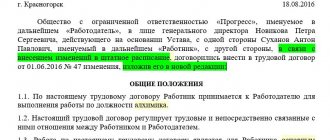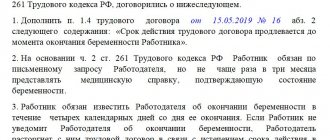Author of the document
| Contract-Yurist.Ru offline Status: Legal company rating460 84 / 6 Private message Order a consultation | number of consultations: |
| noted as the best: | 5 |
| answers to documents: | |
| documents posted: | 927 |
| positive feedback: | |
| negative reviews: |
Main types of agreements
In the case of interest-free loans, there are only two types of agreements with the founder.
They are divided into:
- short-term;
- unlimited
A short-term agreement provides for the designation of an exact date for the return of funds. It is concluded for a period of up to a year. If at the time of repayment the borrower does not have funds and this is provided for in the document, an extension is possible. To extend the validity of the conditions, an additional agreement is concluded indicating a new date. After its signing, the previous document becomes invalid.
A short-term agreement provides for two payment options: either the entire amount or in parts. If the borrower will repay the loan gradually, it is recommended to draw up a payment schedule.
An open-ended contract, as the name suggests, does not contain a specific date for the return of funds. In practice, it is possible to repay the debt at the request of the lender. The borrower returns the money within 30 days from the date of receipt of the written request. An open-ended agreement implies a lump sum payment of the borrowed funds.
Interest-free loan agreement from the founder/member of the company
| (place of conclusion of the contract) | (date of conclusion of the agreement) |
(Full name of the Lender), who is a participant/founder of the Borrower Company, hereinafter referred to as the “Lender”, on the one hand, and
(Full name of the Borrower), represented by (position, full name), acting on the basis of (Charter, Regulations, Power of Attorney), hereinafter referred to as the “Borrower”, on the other hand, and together referred to as the “Parties”, have concluded this agreement on the following:
Subject of the agreement
1.1. Under this Agreement, the Lender transfers the ownership of funds to the Borrower in the amount of (amount and currency of funds), and the Borrower undertakes to return the loan amount to the Lender upon expiration of the period specified in clause 1.2. Agreement.
1.2. The loan is provided for a period of ______________.
1.3. The loan provided under this Agreement is secured (method of securing the obligation).
1.4. No interest is paid on the loan amount.
Rights and obligations of the parties
2.1. The borrower is obliged:
- return to the Lender the received loan amount upon expiration of the period specified in clause 1.2 . actual agreement;
- ensure the fulfillment of your obligation to the Lender;
2.2. The Borrower has the right to repay the loan amount to the Lender ahead of schedule.
2.3. The Lender is obliged to provide the Borrower with borrowed funds within (period) from the moment of signing this Agreement.
Final provisions
3.1. This Agreement is considered concluded from the moment the money is transferred to the Borrower.
3.2. The loan amount is considered repaid at the moment of transfer of funds to the Lender.
3.3. Any changes and additions to this Agreement are valid if they are in writing.
3.4. This Agreement is drawn up in two copies having equal legal force - one for each of the Parties.
3.5. In everything that is not provided for in this Agreement, the Parties are guided by current legislation.
Details and signatures
| Lender | Borrower |
| ______________ Lender ______________ | ______________ Borrower ______________ M.P. |
Download the document “Interest-free loan agreement from the founder of the company”
Taxation
The concluded loan agreement should not have tax consequences because the loan is provided on an interest-free basis, since the lender does not receive any economic benefit.
The borrower also does not receive any benefit, since the funds are provided on a reimbursable basis and will have to be returned. Consequently, the loan received is not income and cannot be included in the tax base.
The exception is cases of long-term delay in payment (more than three years), leading to the write-off of accounts payable based on the expiration of the statute of limitations and the need to include the debt amount in non-operating income. This applies to companies that are on a “simplified” tax system.
If the founder draws up a gift agreement, this amount is included in the non-operating income of the enterprise. In cases where the founder’s share in the authorized capital is less than 50%, this “gift” increases the tax base of the enterprise.
For OSNO - the tax amount will be 20%, for simplified tax system - 6%. If the founder's share is more than 50%, debt forgiveness is recognized as gratuitous financial assistance (Article 251 of the Tax Code of the Russian Federation) and no tax is charged.
In conclusion, we note that the use of an interest-free loan from the founder to a legal entity is a good alternative to a bank loan, allowing the company to attract additional funds to solve its financial problems. Issuing a loan to the company by the founder also meets his interests - he, like no one else, is interested in the profitable activities of his enterprise.
Is it possible to get a loan with bad credit online? Find the answer in the article: loan on a card with a bad credit history. Find out how to get an urgent loan from MFO Denga here.
A loan secured by PTS is described on this page.
Leave a comment on the document
Do you think the document is incorrect? Leave a comment and we will correct the shortcomings. Without a comment, the rating will not be taken into account!
Thank you, your rating has been taken into account. The quality of documents will increase from your activity.
| Here you can leave a comment on the document “Interest-free loan agreement from the founder of the company participant”, as well as ask questions associated with it. If you would like to leave a comment with a rating , then you need to rate the document at the top of the page Reply for |
Loan without interest: what taxes are possible
What tax consequences does an interest-free loan from the founder have? For a loan taken without interest, the issue of taxation also turns out to be related to the presence of mutual dependence between the parties to the transaction and whether the founder is a resident or non-resident. The situations here are:
- There is no dependency. In this case, the lack of taxable income in the form of interest from the lender is completely legal (Clause 1, Article 105.3 of the Tax Code of the Russian Federation). Accordingly, the borrower has no expenses.
- There is a dependency. For her, the inclusion of the founder as a resident becomes significant. If the founder is the founder, then the transaction to provide an interest-free loan is not recognized as controlled (subclause 7, clause 4, article 105.14 of the Tax Code of the Russian Federation). If the founder turns out to be a non-resident, then the absence of interest on the loan makes the transaction not subject to control, since in this case the conditions for him, provided for in Art. 269 of the Tax Code of the Russian Federation.
Thus, an interest-free loan will not have tax consequences in any case.
Read about the reflection of a loan in accounting in the material “Accounting for loans and borrowings in accounting.”
Comments on the document “Interest-free loan agreement from the founder of the company participant”
Reply 0
| 5 Elena Podgor | 07/17/2014 at 22:08:00 Thank you! Everything is clear and clear. It turns out that the lender and the borrower can coincide: for example, the lender is one of the co-founders, and he is also the borrower, but as a director of an LLC? |
Reply 0
| 5 Rufina | 07/29/2014 at 22:11:59 Thank you |
Reply 0
| Olga | 10/03/2014 at 14:09:49 Wonderful site, easy to use!!! |
Reply 0
| 5 Julia | 12/15/2014 at 12:38:34 Convenient service, I quickly found the required document, in which everything is written in essence and there is no confusion. Thank you. |
Reply 0
| 5 Natalia | 02/25/2015 at 15:09:24 What is a method of securing an obligation? |
Personal message | Reply 0
| Chechetkina Ksenia Vladimirovna Status: Lawyer rating 12185 | 02/26/2015 at 20:52:30 reply to Natalya Good evening, Natalya. The method of securing obligations is what ensures the fulfillment of the obligation (how the lender can return his money if the borrower does not return it). For example, it could be a pledge, a stand, etc. Art. 329 of the Civil Code of the Russian Federation. Article 329. Methods of ensuring the fulfillment of obligations 1. Fulfillment of obligations may be ensured by a penalty, a pledge, retention of the debtor’s property, a surety, a bank guarantee, a deposit and other methods provided for by law or contract. 2. The invalidity of an agreement to ensure the fulfillment of an obligation does not entail the invalidity of this obligation (the main obligation). 3. The invalidity of the main obligation entails the invalidity of the obligation securing it, unless otherwise established by law.
|
Reply 0
| [email protected] | 07/28/2015 at 13:40:17 Thank you very much! helped a lot. |
Reply 0
| Olga | 09/04/2015 at 09:19:39 The contract is clear, everything is clearly spelled out and there is nothing superfluous. Thank you! |
Reply 0
| 5 Irina | 10/05/2015 at 11:54:54 The contract example is useful for work, thank you. |
Reply 0
| Natasha | 10/14/2015 at 15:40:12 Thank you. very affordable. |
Reply 0
| nata | 11/10/2015 at 14:09:28 It’s kind of short - it should be made more colorful - in our country they love it - by the time you start reading, by the end you’ll forget what was discussed in the contract. |
Reply 0
| Olga | 11/19/2015 at 15:11:24 Thank you. I found what I was looking for on your site. |
Reply 0
| Zhanette | 12/10/2015 at 09:24:55 Thank you very much, everything is simple and clear. |
Reply 0
| Valentine | 02/04/2016 at 11:43:21 Thank you. Very accurate and good document. |
Reply 0
| Victoria | 09/15/2016 at 12:04:29 Good afternoon, tell me, is it possible to extend such an agreement with an additional agreement? |
Reply 0
| 5 Inna | 04/03/2017 at 12:52:46 Thank you. The agreement is quite clearly stated. |
Personal message | Reply 0
| 5 Natalia Status: Client | 06/09/2018 at 17:03:59 Thank you very much. The agreement is laconic, clearly formulated, without frills or “fluff”. |
Reply 0
| 5 Svetlana | 07/03/2018 at 19:37:07 Thank you. Exactly what is needed. |
How to calculate personal income tax
According to Article 224 of the Tax Code of the Russian Federation, the tax rate on income from material benefits is calculated as 35 percent. The base on which the tax is calculated is 2/3 of the refinancing rate, which is currently 7.25%. The personal income tax amount is calculated on the last day of the month using the formula:
Personal income tax = debt amount * 2/3 refinancing rates * 35%
Example 1.
June 01, 2020 Pasechev A.A. borrowed 200,000 rubles from Reshenie LLC, in which he is a founder. The loan was issued as interest-free, as stated in the contract. As of June 30, 2020, Pasechev A.A. A material benefit arose on which personal income tax was assessed in the following amount:
200000*4.83%*35%=3381 rubles.
Found documents on the topic “interest-free loan agreement from the founder sample”
- Interest-free loan agreement from the founder of a company participant Money loan agreement → Interest-free loan agreement from the founder of a company participant
-free loan agreement from a founder /member of the company (place of conclusion of the agreement ) ... - Agreement interest-free loan from founder company member (2)
Money loan agreement → Interest-free loan agreement from the founder of the company participant (2)-free loan agreement from the founder /member of the company (place of conclusion of the agreement ) ...
- Sample. Agreement loan (interest-free) with payment of the amount loan in parts
Money loan agreement → Sample. Loan agreement (interest-free) with payment of the loan amount in installmentsloan agreement ( interest-free ) "" 20 citizen, hereinafter referred to as (last name, first name, patronymic) " lender ",...
- Sample. Agreement loan (interest-free)
Money loan agreement → Sample. Loan agreement (interest-free)loan agreement ( interest-free ) "" 20, hereinafter referred to as (name of organization) " lender ", represented by, ...
- Sample. Agreement interest-free loan between a shareholder of a closed joint stock company and the company
Money loan agreement → Sample. Interest-free loan agreement between a shareholder of a closed joint-stock company and the company...and the board of directors (name of company) minutes no. dated "" 20, Chairman of the Board of Directors \\ loan agreement no. ( interest-free ) "" 20 closed joint-stock company, called (name of the company) in ...
- Agreement loan (interest-free)
Money loan agreement → Loan agreement (interest-free)loan agreement ( interest-free ) (date of conclusion of the agreement ), called ...
- Sample. Agreement interest-free loan between an employee of a closed joint stock company and the company
Money loan agreement → Sample. Interest-free loan agreement between an employee of a closed joint-stock company and the company...and the board of directors (name of company) minutes no. dated "" 20, Chairman of the Board of Directors \\ loan agreement no. ( interest-free ) "" 20 closed joint-stock company, called (name of the company) in ...
- Sample. Agreement interest-free loansecured by a guarantee between the shareholder of a closed joint stock company and the company
Money loan agreement → Sample. Agreement on an interest-free loan secured by a guarantee between a shareholder of a closed joint-stock company and the company...and the board of directors (name of company) minutes no. dated "" 20, Chairman of the Board of Directors \\ loan agreement no. ( interest-free ) "" 20 closed joint-stock company called (name of the company) in yes ...
- Agreement loan (interest-free) with an employee
Debt, loan agreement → Loan agreement (interest-free) with an employeeagreement No. of a loan ( interest-free ) with an employee of the city, hereinafter referred to as the “ lender ”, in ...
- Sample. Agreement interest-free loan between a shareholder of a closed joint-stock company and a company with collateral (property pledge)
Money loan agreement → Sample. Interest-free loan agreement between a shareholder of a closed joint-stock company and a company with collateral (property pledge)...and the board of directors (name of company) minutes no. dated "" 20, Chairman of the Board of Directors \\ loan agreement no. ( interest-free ) "" 20 closed joint-stock company, called (name of the company) in ...
- Sample. Agreement interest-free loan between an employee of a closed joint stock company and a company with collateral (property pledge)
Money loan agreement → Sample. Interest-free loan agreement between an employee of a closed joint-stock company and a company with collateral (property pledge)...and the board of directors (name of company) minutes no. dated "" 20, Chairman of the Board of Directors \\ loan agreement no. ( interest-free ) "" 20 closed joint-stock company called (name of the company) in yes ...
- Sample. Agreement pledge of an apartment owned by the pledgors to ensure the return of the amount loan By agreement loan
Pledge and pledge agreement → Sample. Pledge agreement for an apartment owned by the mortgagors to ensure repayment of the loan amount under the loan agreementcontract no. pledge of property (apartment) "" 20 closed joint-stock company, (name of company) named after...
- Sample. Agreement pledge of an apartment owned by the borrower to ensure repayment of the amount loan By agreement loan with collateral
Pledge and pledge agreement → Sample. An agreement to pledge an apartment owned by the borrower to ensure repayment of the loan amount under a secured loan agreementcontract no. pledge of property (apartment) "" 20 closed joint-stock company, (name of company) named after...
- Agreement loan (interest on the amount loan paid simultaneously with the principal amount loan upon expiration of the period for which the loan is provided)
Money loan agreement → Loan agreement (interest on the loan amount is paid simultaneously with the principal amount of the loan upon expiration of the period for which the loan is provided)loan agreement (date of conclusion of the agreement ), hereinafter referred to as...
- Sample. Agreement between founder and the newspaper editors
Founding agreements, charters → Sample. Agreement between the founder and the editorial board of the newspaperapproved by decree of the government of the Russian Federation of February 28, 1994 no. 157 agreement the government of the Russian Federation (hereinafter referred to as the founder ) represented by the Minister of the Russian Federation - head of the a...
How to write off an issued loan?
A loan to the founder can be written off in two cases:
- In case of full repayment.
- In case of registration of a debt forgiveness procedure.
Refund
In accordance with the concluded agreement, the founder can repay the interest-free loan either in full or in part, on time or ahead of schedule, as well as on a deferred date by agreement of the parties.
Depending on the method of return, amounts are reflected in accounting entries:
- Dt 50 Kt 66, 67 – return in cash to the cash desk of a short-term or long-term loan.
- Dt 51 Kt 66, 67 – repayment of a short-term or long-term loan through a credit institution.
Debt forgiveness
Any person can forgive a debt to another person, either completely or partially. From a legal point of view, this is an ordinary transaction. Debt forgiveness is regulated by Art. 415 of the Civil Code of the Russian Federation. The law does not impose any special requirements for the loan forgiveness procedure on the founder.
As a general rule, a debt can be forgiven if this fact does not violate the rights of other persons in relation to the lender's property.
According to the Civil Code of the Russian Federation, the debt is considered forgiven from the moment the borrower receives notice of the debt being written off. The debtor may object to the forgiveness of the debt within a reasonable time.
The fact of forgiveness from the date of receipt of the notice is reflected in paragraph 2 of Art. 415 of the Civil Code of the Russian Federation, this clause was introduced relatively recently. Before the advent of this norm, the parties formalized the forgiveness procedure in other ways.
- Drawing up a gift agreement.
- Concluding a debt forgiveness agreement. Often, participants in borrowing relationships consider unilateral notification insufficient and enter into a bilateral agreement. This is not prohibited by law, but it would be redundant. In addition, on the basis of this agreement, in any case, it will be necessary to send the debtor a notice of debt forgiveness.
Regardless of the method of writing off the debt to the founder, the latter receives a material benefit, with which it is necessary to pay personal income tax at a rate of 13%.
The forgiven debt cannot be expensed and therefore reduce the taxable base. This type of cost is not reflected in Art. 346.16 Tax Code. The amount of forgiven debt is included in profit, that is, it is a direct loss for the enterprise.
Related documents
- Interest-free loan agreement from the founder of the company (2)
- Loan agreement (interest-free)
- Loan agreement (loan repayment is carried out in installments)
- Loan agreement (interest on the loan amount is paid simultaneously with the principal amount of the loan upon expiration of the period for which the loan is provided)
- Targeted loan agreement
- An agreement to borrow money with payment of interest.
- Loan agreement between individuals
- Money loan agreement
- Additional agreement on extending the term of a loan agreement concluded to pay for repairs and restoration of a car owned by the borrower
- Loan agreement
- Loan agreement (option 2)
- Sample. Interest-free loan agreement between a shareholder of a closed joint-stock company and the company
- Sample. Interest-free loan agreement between a shareholder of a closed joint-stock company and a company with collateral (property pledge)
- Sample. Interest-free loan agreement between an employee of a closed joint-stock company and the company
- Sample. Interest-free loan agreement between an employee of a closed joint-stock company and a company with collateral (property pledge)
- Sample. Agreement on an interest-free loan secured by a guarantee between a shareholder of a closed joint-stock company and the company
- Sample. Loan agreement (interest-free)
- Sample. Loan agreement (interest-free) with payment of the loan amount in installments
- Sample. Loan agreement with collateral
- Sample. A loan agreement concluded to pay for the repair and restoration of a car owned by the borrower
- Sample. Regulations on the conditions and procedure for providing loans to employees and shareholders of a closed joint stock company
- Sample. The borrower's receipt of the amount of money under the loan agreement
- Sample. Receipt from the lender for receipt of the entire amount of money under the loan agreement
- Sample. Receipt from the lender for receiving part of the amount of money under the loan agreement
- Sample. A fixed-term obligation of an individual borrower under a loan agreement concluded between an employee (shareholder) of a closed joint-stock company and the company
- Sample. Agreement on borrowing money with a penalty
- Sample. Agreement on the termination of an obligation by agreement of the parties to replace one obligation with another, as well as its fulfillment
Accounting entries
Depending on the term, loans are divided into short-term (up to 1 year) and long-term (over one year).
Depending on the type of loan and the source of its issuance, the following entries will be made in accounting:
- Dt 66 Kt 50 – issuance of a short-term loan from the cash register.
- Dt 67 Kt 50 – issuance of long-term loans from the cash register.
- Dt 66 Kt 51 - issuing short-term loans through a bank.
- Dt 67 Kt 51 – issuance of long-term loans through a bank.
Comment on the rating
Thank you, your rating has been taken into account. You can also leave a comment on your rating.
Is the sample document useful?
If the document “Interest-free loan agreement from the founder of the company” was useful to you, we ask you to leave a review about it.
Remember just 2 words:
Contract-Lawyer
And add Contract-Yurist.Ru to your bookmarks (Ctrl+D).
You will still need it!
Material benefit
Sometimes company owners think that they can just borrow money from their company and not pay it back for years. And then, as they say, we’ll figure it out. This is done in order to withdraw funds from the cash register from the LLC's current account. But this position of the founders is fundamentally wrong, because when issuing an interest-free loan for one of the founders, he receives a so-called material benefit. This is the income that the founder “receives” from the fact that he does not have to pay interest on the loan.









